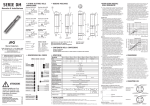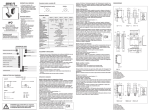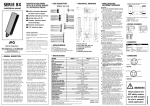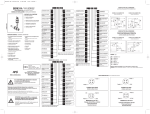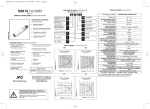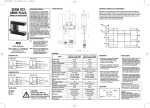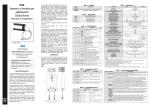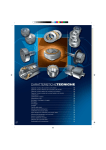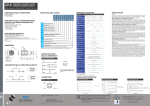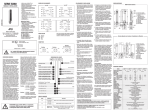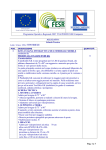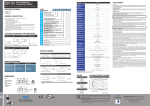Download SERIE SSF - AutomationDirect
Transcript
Uscita NPN 1 Bn carico 100mA +10-30 VDC Uscita cavo, 4x0,34mm2, Ø4,7mm, PVC, 2m Uscita connettore M12 Pulsante di teach-in Ghiera per fissaggio fibra (inclusa) 4 Bk + impulso buio 2 Wh n.c impulso luce - teach OV 3 Bu • CONTENUTO DELLA CONFEZIONE Manuale di Installazione N°1 amplificatore SSF per fibre ottiche • N°2 ghiere M18 (plastiche per SSF/**-0*, metalliche SSF/**-1* ) • SPECIFICHE Uscita PNP 1 Bn TIPO +10-30 VDC + impulso buio 2 Wh carico 100mA 4 Bk n.c impulso luce - teach OV 3 Bu CODICE COLORI www.microdetectors.com [email protected] 1/Bn : Brown/Marrone 2/Wh : White/Bianco 3/Blu : Blue/Blu 4/Blk : Black/Nero N.B In caso di carico misto resistivo e capacitivo la massima capacità ammessa è di 0,1 µF per tensioni e correnti di uscita massime. Amplificatore M18 per fibre ottiche plastiche o in vetro Regolazione digitale della sensibilità mediante pulsante di teach-in o cavo remoto Led multifuzione con indicazione del livello del segnale Distanza di rilevazione: • Tasteggio diretto: 50 mm (con CF/CB1) • Barriera: 120 mm (con CF/RB6) Emissione : rossa (660 nm) Materiale contenitore: PBT (corpo plastico), ottone nichelato (corpo metallico) Uscita: NPN o PNP, 100 mA, con protezione al cortocircuito. • DESCRIZIONE DEL CODICE SSF / 0 N - 0 A SSF Stato uscita LOn / DOn selezionabile A Attacco di uscita Uscita cavo assiale 4 poli E Uscita connettore M12 Contenitore 0 0 Contenitore plastico 1 Contenitore metallico Tipo uscita N Uscita NPN P Uscita PNP Cortocircuito ( autoripristinante ) -25 °C / +70 °C ( senza condensa) 10% Sr 3000 lux (lampada incandescenza) , 10000 lux (luce solare) IP67 (EN60529) • TABELLA DELLE FIBRE OTTICHE • DESCRIZIONE GENERALE Serie sensore M18 a fibra ottica ≤10 % +15/-5% 5% 10 – 30 Vdc 10 % 20 mA 10 µA 100 mA NPN o PNP , LOn / DOn selezionabile 1.8 V max a 100 mA 150 ms 800 Hz Inversione di polarità , sovratensioni impulsive ATTENZIONE (1) Questo prodotto non è un sensore di sicurezza e non può essere utilizzato come protezione di accesso a zone pericolose MODELLO(1) TIPO CF/CA2-** Riflessione diretta 15mm 0,5mm NO 0,5 – 1m M4 Distanza di Rilevazione øFIBRA (nucleo) TAGLIABILE LUNGHEZZA Terminazione (mm) CF/CA4-** Riflessione diretta 15 mm 0,5 mm NO 0,5 – 1m M4 con sleeve CF/RA4-** Barriera 30mm 0,5mm NO 0,5 – 1m M4 con sleeve CF/RA7-** Barriera 30mm 0,5mm NO 0,5 – 1m M4 con sleeve CF/CB1-** Riflessione diretta 50mm 1mm SI 1-2 m M6 CF/RB4-** Riflessione diretta 50mm 1mm SI 1-2 m M6 con sleeve M4 con sleeve CF/CB3-** Barriera 120 mm 1mm SI 1-2 m CF/RB6-** Barriera 120 mm 1mm SI 1-2 m M4 CF/RB9-** Barriera 1200 mm 1mm SI 1-2 m ø6 con lenti CF/RBA-** Barriera 1200 mm 1mm SI 1-2 m M7 con lenti CF/CC1-20 Riflessione diretta 15mm 1mm NO 2m M6 CF/RC6-20 Barriera 100mm 1mm NO 2m M4 CF/RC9-20 Barriera 1000mm 1mm NO 2m ø6 con lenti CF/RCA-20 Barriera 1000mm 1mm NO 2m M7 con lenti CV/CB1-** Riflessione diretta 50 mm 1mm NO 1-2 m M4 CV/CB3-** Riflessione diretta 50mm 1mm NO 1-2 m M4 con sleeve CV/RB4-** Barriera 90 mm 1mm NO 1-2 m M4 con sleeve CV/RB6-** Barriera 90 mm 1mm NO 1-2 m M4 Sono possibili due tipi di regolazione , regolazione standard e regolazione fine della sensibilità del dispositivo. La regolazione fine è ottimale per ottenere la massima sensibilità nella rilevazione di oggetti piccoli e semitrasparenti; nel caso di oggetti opachi e di dimensioni maggiori o qualora lo sfondo non influenzi la lettura è conveniente utilizzare la regolazione standard , garantendo al sistema la possibilità di lavorare anche in ambienti gravosi. Tasteggio diretto. Dopo avere installato l’unità e le terminazioni delle fibre posizionare l’oggetto da rilevare alla distanza di lettura desiderata , verificando che l’asse ottico sia perpendicolare alla superficie dell’oggetto. Assumendo le peggiori condizioni ( oggetto statisticamente più piccolo e oggetto o parte di esso più scura rispetto allo sfondo) posizionare l’oggetto nel punto più distante che può assumere rispetto al sensore. Premere il pulsante di teach o collegare il pin 2 (cavo bianco) a massa per 2…5 sec. fino a quando il LED di segnalazione giallo non si riaccende in modo stabile. La soglia viene posta al 50% del segnale rilevato e si ha una regolazione standard della sensibilità del dispositivo. Togliere l’oggetto e verificare lo spegnimento del led giallo. Nel caso il led giallo rimanga acceso occorre una regolazione fine della sensibilità . Per effettuare la regolazione fine collegare il pin 2 (cavo bianco) a massa o premere il pulsante di Teach-in per t > 8sec. fino a quando il LED di segnalazione giallo non inizia a lampeggiare, la soglia viene posta al di sotto del segnale rilevato di una quantità pari all’isteresi. Togliere l’oggetto e verificare lo spegnimento del LED giallo. Emettitore / Ricevitore. Dopo avere installato l’amplificatore posizionare le terminazioni in opposizione una rispetto l’altra all’interno della distanza di rilevazione. Regolare accuratamente la posizione reciproca di ricevitore ed emettitore fino all’accensione del led giallo , fissando provvisoriamente le terminazioni al centro di questa zona. Per ottenere un allineamento ottimale seguire la procedura seguente. Premere il pulsante di teach o collegare il pin 2 (cavo bianco) a massa per t > 8sec sec. fino a quando il LED di segnalazione giallo non inizia a lampeggiare. Allineare reciprocamente il ricevitore rispetto all’emettitore cercando di ottenere uno stato del led acceso stabile o eventualmente una diminuzione della frequenza di lampeggio. Ripetere l’operazione fino a quando non sia più possibile variare la frequenza del lampeggio del LED giallo. In tali condizioni si è effettuata una regolazione fine della sensibilità del dispositivo. Tale regolazione risulta ottimale per la rilevazione precisa di piccoli oggetti o per la rilevazione di oggetti semitrasparenti. Per le applicazioni in cui si devono intercettare oggetti non trasparenti e di dimensioni superiori al diametro della fibra ( dopo avere effettuato le operazioni precedentemente indicate) , si consiglia di usare la regolazione standard , in questo modo si avrà il massimo margine di immunità nei confronti della polvere e dello sporco che si può depositare sulle ottiche. Per ottenere una regolazione standard premere il pulsante di teach o collegare il pin 2 (cavo bianco) a massa per 2…5 sec. fino a quando il LED di segnalazione giallo non si riaccende in modo stabile. Regolazione con configurazione impulso buio Se è necessario utilizzare l’ingresso di Teach con una configurazione IMPULSO BUIO (DARK ON) si deve aggiungere un resistore di 2.2 KΩ per evitare il corto circuito con l’alimentazione quando il Teach è attivo 1 10...30 Vdc (1) Gli ultimi due bit del codice indicano la lunghezza dalla fibra (in dm) –(2) Lunghezza standard. Lunghezze speciali disponibili su richiesta. 2.2 K Ω Strada S.Caterina, 235 - 41100 Modena Italy Tel. +39 059 420411 Fax +39 059 253973 Fotocellula M18 a fibbra ottica Corsa differenziale Tolleranza Ripetibilità Tensione di alimentazione Ondulazione residua Corrente assorbita Corrente di perdita Corrente di uscita Tipo di uscita Caduta di tensione in uscita Ritardo alla disponibilità Frequenza di commutazione Protezioni elettriche alimentazione Protezioni elettriche uscita Limiti di temperatura Deriva termica Interferenza alla luce esterna Grado di protezione • FISSAGGIO FIBRE OTTICHE • MONTAGGIO 1 Svitare non completamente la ghiera blocca fibra. Inserire completamente la fibra ottica prestando attenzione che tocchi il fondo della sede (vincendo la leggera resistenza provocata dalla guarnizione di tenuta) e serrare saldamente la ghiera di fissaggio. 2 Non applicare alle fibre una forza maggiore di 3Kg. Non tirare le fibre e rispettare sempre il raggio di curvatura minimo indicato (5 mm per fibre Ø 0,5 , 10mm per fibre Ø 1 e 30 mm per fibre in vetro ). 3 Fissare le fibre con passacavi di nylon in modo da non esercitare pressioni deformanti sulla fibra che ne potrebbero compromettere il funzionamento. 1 Prestare attenzione al taglio che deve essere eseguito in maniera corretta utilizzando il cutter AF/C fornito a corredo. 2 Non riutilizzare un foro già utilizzato in quanto aumentano le possibilità di taglio irregolare con possibili riduzioni della sensibilità. il sensore all'interno della distanza nominale di lavoro. Per verificare se il sensore è in grado di regolare la sensibilità correttamente , è consigliabile effettuare sempre una regolazione fine ed accertarsi dello stato lampeggiante del led al termine della procedura. Se il led rimane fisso , il sensore lavora ad una distanza troppo elevata in rapporto all’oggetto da rilevare o il sensore non è correttamente allineato. Se è sufficiente rilevare la presenza di oggetti e non si è influenzati da sfondi o altri oggetti dietro quello da rilavare, è possibile utilizzare il sensore fino alla distanza indicata nelle curve e nel caso ripetere la taratura effettuando una regolazione standard. Le curve indicano il rapporto tra la posizione in cui il sensore viene posto per effettuare la regolazione di sensibilità e la posizione in cui il sensore si attiva con un margine >=2. Regolazione con CF/CB1 Don/Doff (cm) Manuale di installazione • REGOLAZIONE DIGITALE DELLA SENSIBILITA’ 16 14 Doff carta bianca 12 10 Don carta bianca 8 Doff carta nera 6 4 Don carta nera 2 0 0 1 2 3 4 5 6 7 8 9 Regolazione con CF/RB6 36 32 Doff 28 24 Don 20 16 12 8 4 0 0 2 4 6 8 10 12 14 16 18 20 22 24 Note sulla regolazione. Oltre la distanza nominale del sensore la regolazione fine non ha più influenza sulla distanza di intervento sia nel caso di utilizzo a barriera che di utilizzo a tasteggio diretto. Come si può vedere dalle curve seguenti l’isteresi aumenta all'aumentare della distanza di regolazione. Se occorre avere una regolazione fine è necessario utilizzare 28 • CONNESSIONI 1 Assicurarsi che la tensione di alimentazione sia correttamente stabilizzata con una ondulazione residua (ripple) compresa all’interno dei dati di catalogo. 2 Utilizzando uno stabilizzatore di tensione di tipo “switching” assicurasi che il terminale di massa sia connesso a terra come il comune del sensore. 3 Nel caso che il rumore indotto dalle linee di potenza risulti superiore a quello previsto dalla normativa CE (immunità ai dis-turbi), separare i cavi del sensore dalle linee di potenza e di alta tensione e inserire il cavo in una canalina metallica connessa a massa. E’ consigliabile inoltre, collegare il sensore direttamente alla sorgente di alimentazione e non a valle di altri dispositivi. 4 Per estendere i cavi di alimentazione e uscita utilizzare un cavo avente conduttori di sezione minima di 1 mm2. Il limite dell’estensione in lunghezza è 100m (riferiti a tensione minima e corrente al carico di 100mA). 5 Lo stato del sensore diventa valido solo dopo 150ms dalla for-nitura di alimentazione (ritardo alla disponibilità). In questo periodo le uscite saranno OFF. Non utilizzare il segnale di uscita durante questo intervallo di tempo. • CONNETTORE (Uscita) 3 OV 26 Distanza regolazione alimentazione (-) 4 Uscita Luce 2 Impulso Impulso Buio 10 Distanza regolazione Don/Doff (cm) SERIE SSF • DISEGNI MECCANICI 4 3 1 2 Alimentazione (+) Impulso luce/buio regolazione remota Two types of sensitivity adjustment are available, standard adjustment and fine adjustment. Fine adjustment is ideal for achieving the greatest sensitivity for the detection of small and semi-transparent objects; if the target objects are opaque or of larger dimensions, or if the background does not affect the reading, standard adjustment should be used as it guarantees that the system can operate in harsh environments. NPN Output 1 Bn load 100mA +10-30 VDC Cable exit, 4x0,34mm2, Ø4,7mm, PVC, 2m M12 plug cable exit Teach-in button Locking ring nut (supplied) 4 Bk + dark on 2 Wh n.c light on - teach OV 3 Bu • SUPPLIED MATERIAL Installation Manual N°1 photoelectric sensor SSF for optical fibres • N°2 M18 ring nut (plastic for SSF/**-0*, metal for SSF/**-1*) • SPECIFICATIONS PNP Output 1 Bn MODEL +10-30 VDC + dark on 2 Wh load 100mA 4 Bk n.c light on - teach OV 3 Bu WIRING COLORS www.microdetectors.com [email protected] 1/Bn : Brown 2/Wh : White 3/Blu : Blue 4/Blk : Black NOTE. In case of combined load , resistive and capacitive, the maximum admissible capacity is 0,1 µF for maximun output voltage and current • OTICAL FIBRES TABLES • GENERAL DESCRIPTION M18 amplifier for plastic or glass optical fibres Digital sensitivity adjustment by teach-in button or remote cable Multifunction LED with signal level indication Sensing distance: • Diffused reflection: 50 mm (with CF/CB1) • Through beam: 120 mm (with CF/RB6) Emission : red (660 nm) Housing Material: PBT (plastic housing), nickel-plated brass (metal housing) Output : NPN or PNP, 100 mA, with short circuit protections. • CODE DESCRIPTION SSF / 0 N - 0 A Series M18 photoelectric sensors for optical fibre SSF A Cable exit Axial cable exit E M12 plug cable exit WARNING These products Housing 0 0 Plastic housing 1 Metal housing and are NOT suitable for use in personal Output type N NPN output P PNP output MODEL(1) TYPE FREE-CUT LENGHT Head shape (mm) CF/CA2-** Diffuse reflection 15mm 0,5mm NO 0,5 – 1m M4 Sensing distance øFIBRE (core) CF/CA4-** Diffuse reflection 15 mm 0,5 mm NO 0,5 – 1m M4 with sleeve CF/RA4-** Trough beam 30mm 0,5mm NO 0,5 – 1m M4 with sleeve CF/RA7-** Trough beam 30mm 0,5mm NO 0,5 – 1m M4 with sleeve CF/CB1-** Diffuse reflection 50 mm 1mm YES 1-2 m M6 CF/RB4-** Diffuse reflection 50mm 1mm YES 1-2 m M6 with sleeve M4 with sleeve CF/CB3-** Trough beam 120 mm 1mm YES 1-2 m CF/RB6-** Trough beam 120 mm 1mm YES 1-2 m M4 CF/RB9-** Trough beam 1200 mm 1mm YES 1-2 m ø6 with lens CF/RBA-** Trough beam 1200 mm 1mm YES 1-2 m M7 with lens CF/CC1-20 Diffuse reflection 15mm 1mm NO 2m M6 CF/RC6-20 Trough beam 100mm 1mm NO 2m M4 CF/RC9-20 Trough beam 1000mm 1mm NO 2m ø6 with lens M7 with lens CF/RCA-20 Trough beam 1000mm 1mm NO 2m CV/CB1-** Diffuse reflection 50 mm 1mm NO 1-2 m M4 CV/CB3-** Diffuse reflection 50mm 1mm NO 1-2 m M4 with sleeve CV/RB4-** Trough beam 90 mm 1mm NO 1-2 m M4 with sleeve CV/RB6-** Trough beam 90 mm 1mm NO 1-2 m M4 (1) are NOT safety sensors Output state LOn/DOn selectable ≤10 % +15/-5% 5% 10 – 30 Vdc 10 % 20 mA 10 µA 100 mA NPN or PNP , Lon / Don selectable 1.8 V max at 100 mA 150 ms 800 Hz Polarity reversal , transient Short circuit ( autoreset ) -25 °C / +70 °C ( without freeze) 10% Sr 3000 lux (incandescent lamp) , 10000 lux (sunlight) IP67 (EN60529) safety application Diffused reflection. After having installed the unit and the fibre terminations, position the target object at the required sensing distance , checking that the optical axis is perpendicular to the surface of the object. Assuming the worst possible conditions (object statistically smaller and object or part of object darker than the background), position the object at the furthest possible point from the sensor. Press the teach button or connect pin 2 (white cable) to earth for 2-5 secs. until the yellow signal LED switches back on constantly. The threshold is set at 50% of the detected signal, thus giving the device a standard sensitivity adjustment. Remove the object and check that the yellow LED has switched off. If the yellow LED remains switched on, fine sensitivity adjustment is required. To carry out the fine adjustment connect pin 2 (white cable) to earth or press the Teach-in button for t > 8 secs. until the yellow signal LED starts flashing. The threshold is set below the detected signal of the hysteresis amplitude. Remove the object and check that the yellow LED has switched off. Emitter / Receiver. After having installed the amplifier, position the terminations diametrically opposed within the sensing distance. Carefully adjust the relative positions of the receiver and the emitter until the yellow LED switches on, provisionally fixing the terminations in the centre of this area. To achieve the best alignment, use the following procedure. Press the teach button or collect pin 2 (white cable) to earth for t > 8 secs. until the yellow signal LED starts flashing. Align reciprocally the receiver and the emitter until the LED is constantly switched on or at least until the frequency of the flashes decreases. Repeat the operation until it is no longer possible to vary the frequency at which the yellow LED flashes. In this way a fine sensitivity adjustment of the device has been carried out. This adjustment is ideal for the accurate detection of small objects or for the detection of semi-transparent objects. For applications in which the target objects are not transparent or are larger than the diameter of the fibre ( after the operation before indicated) , the standard adjustment is recommended. This gives the highest possible margin of immunity to the dust or dirt which can deposit on the optical elements. To carry out a standard adjustment press the teach button or connect pin 2 (white cable) to earth for 2-5 secs. until the yellow signal LED switches back on constantly. Teach with Dark ON configuration Should it be necessary to use the teach input with a DARK ON configuration 2.2 KΩ resistor must be added to avoid short circuits in the power supply when the teach mode is active. 1 10...30 Vdc Sensitivity adjustment with CF/CB1 16 14 Doff white paper 12 10 Don white paper 8 Doff black paper 6 4 Don black paper 2 0 0 1 2 3 4 5 6 7 The last two bit of the code show the fiber lenght (in dm) –(2) Standard length. Special lengths are available on request. 4 out • OPTICAL FIBRE MOUNTING • INSTALLATION 2 LOn/DOn 1 Unscrew not completely but work loose the locking ring nut. Then connect the optical fibres and make sure to get the bottom of the slot (sealing will be causing a light resistance). Tighten the locking nut firmly. 2 Do not apply undue force to the fibres. They endure a force of 3Kg. Do not pull the fibres and respect the indicated minimum bending radius (5mm for Ø 0,5 , 10 mm for Ø 1 and 30 mm for glass optical fibres) . 3 Fibres can be fixed with leads of nylon, cable clamps as to not exert any deforming pressure on the fibres which could affect detection. 1 Take care when effecting the cut which shall be done correctly as to secure a perfect optical connection. Cut the fibres unit with the cutter AF/C supplied as an accessory. 2 Do not use each hole more than once because the cut may be rough, resulting in shortening the detecting distance. 3 OV Adjustment notes. Beyond the nominal distance of the sensor, the fine adjustment has no effect on the operating distance. As shown from the curves, the hyteresis increases with a correspondent increase in the teach distance. If a fine adjustment is required, the sensor must be used within the nominal sensing distance. To check if the sensor is 8 9 10 Teach distance (cm) Sensivity adjustament with CF/RB6 36 32 Doff 28 24 Don 20 16 12 8 4 0 0 2 4 6 8 10 12 14 16 18 20 22 24 26 28 Teach distance (cm) • CONNECTIONS 1 Make sure that the operating voltage is correctly stabilized with a maximum ripple being within the specified figure as stated in the catalogue. 2. When using a “switching” regulator for the power source, be sure to earth both the frame round terminal and the sensor. 3 In the event that the noise induced by the power lines is greater than that specified by the EC regulation (interference immunity), detach the sensor cables from the power and high voltage lines and insert the cable in an earthed metal conduit. Furthermore, it is advisable to connect the sensor directly to the supply source and not downstream of other devices. 4 To extend the supply and output cables, a cable with a minimum cross-section of 1mm2 must be used. The length of such an extension is limit to a maximum of 100m (with respect to a minimum voltage and load current of 100mA). 5 The sensor will become active 150ms after supply voltage is applied. During this time, the outputs will be OFF. • CONNECTOR 2.2 K Ω Strada S.Caterina, 235 - 41100 Modena Italy Tel. +39 059 420411 Fax +39 059 253973 M18 photoelectric sensor for optical fibre Differential travel Tolerance Repeat accurancy Operating voltage Ripple No load current Leakage current Load current Output type Output voltage drop Time delay before availability Switching frequency Supply electrical protection Output electrical protection Temperature range Temperature drift Interference from external light Protection degree capable of adjusting the sensitivity correctly, it is always advisable to carry out a fine adjustment and to make certain that the LED is flashing at the end of the procedure. If the LED remains constant, either the sensor operates at too high distance in relation to the target object or the sensor is not correctly aligned. If it is sufficient only to detect the presence of objects and this is not affected by backgrounds or other objects behind those to be detected, the sensor can be used till the distance indicated in the curves is reached. If necessary, repeat the setting by carrying out a brief teach. The curves represent the relationship between the position in which the sensor is placed to carry out the sensitivity adjustment and the position in which the sensor is activated with an margin >=2. Don/Doff (cm) Installation Manual • DIGITAL SENSITIVITY ADJUSTMENT Don/Doff (cm) SERIE SSF • MECHANICAL DRAWINGS (OUT) Supply (+) Supply (-) 4 3 1 2 Light/Dark/Teach


